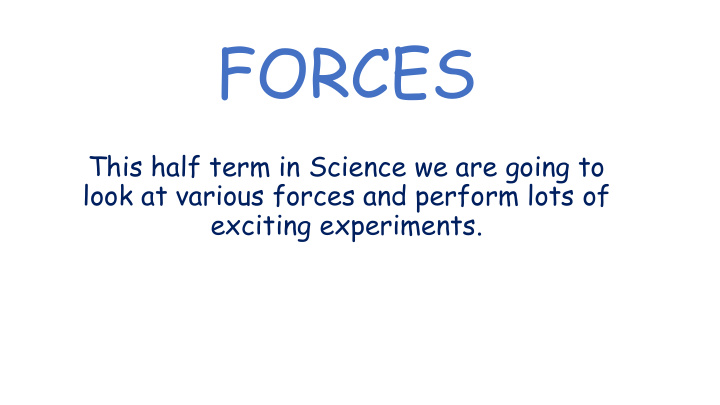



FORCES This half term in Science we are going to look at various forces and perform lots of exciting experiments.
Can you match the force to its description? Water Air Upthrust Gravity Friction resistance resistance Water or air pushes back This force, also known as against an object placed drag, is friction between in it. If this force is the a moving object and the same as the weight of the air around it. object, it will float. Is the force between two Is the force that pulls This force is friction things that are moving (or things together. This pull between water and an object trying to move) across is because objects have that is moving through it. each other. This force mass. The bigger the The water pushes against the slows a moving object. mass, the bigger the pull. object and slows it.
Answers Water Air Upthrust Gravity Friction resistance resistance Is the This force is Is the force This force, also Water or air force that friction between between two known as drag, is pushes back pulls things water and an things that friction between against an together. object that is are moving a moving object object placed This pull is moving through (or trying to and the air in it. If this because it. The water move) across around it. The force is the objects pushes against each other. air pushes same as the have mass. the object and This force against the weight of the The bigger slows it. slows a object and slows object, it will the mass, moving it. float. the bigger object. the pull.
Welcome to … The Ecclesall E -lympics Eggvent 1: Shot putt Eggvent 3: Parachute jump Eggvent 2: Eggvent 4: Grand Prix Boat race
The Ecclesall E -lympics Eggvent 1: Shot putt Design a catapult/trebuchet with any materials you have (wood, card, LEGO, string, rubber bands etc) which will propel an object (hard boiled egg/plastic egg/tennis ball etc) for a distance. Design Brief Catapults must be free standing • They must be able to hold and launch an object safely. • The base must be no more than 30cm2 • Key Words Fulcrum, load, force, air resistance, gravity.
You will need to understand levers to make your catapult. Scientific Play Take a ruler, pencil and two coins of different weights. Place the ruler on the pencil and place the coins at either end. Can you make the ruler balance? Can you make other objects of different weights balance?
All levers have four basic parts: Beam – the lever, a wooden plank or metal bar resting on the fulcrum. • Fulcrum – the pivot or the turning point. • Force – the effort or input needed to move the beam and load. • Load – the item or object being moved or lifted on the plank. • How it works: If one end of the lever is pushed down, the force will lift the other end. If the other end has a load on top of it, it will be easier to move the load. Think of a boy and girl on a see saw. The boy may not be able to lift the girl up in the air using just his arms. On a see saw, though, the girl (the load) is sitting on one end and then the boy can easily push down on the other end and lift the girl.
Eggvent 1: Shot putt Your task is to design a catapult/trebuchet to launch (shot putt) an object as far as safely possible. Think about the following questions: 1. What makes my design successful? stable / strong / length of lever / force applied / position of fulcrum … 2. What would improve my design? d ifferent materials / different design … 3. How can I make the ball travel further/higher? consider air resistance / consider gravity / force …
Eggvent 1: Shot putt Research designs of catapults. What makes them work well. Think about how you can reduce air resistance and account for gravity. Design your catapult on the design sheet. Give detail of materials to be used and measurements of your design. You can use an extra sheet to write up what you researched. Build your catapult and test it. What can you change to make the object travel further. Record your longest launch. Take a photo of your catapult, we can’t wait to see the different designs.
Recommend
More recommend